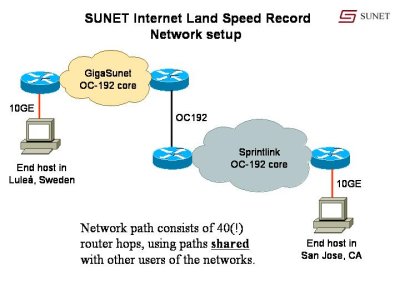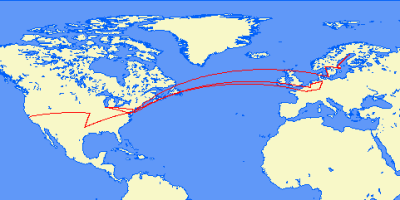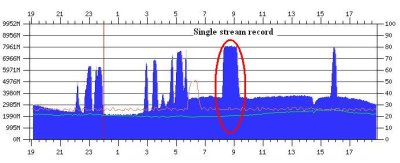SUNET Internet2 Land Speed Record: 124.935 Pbmps (single stream).
Swedish University Network
Börje Josefsson 2004-04-14
SUNET is the organization for the national higher research and education network (NREN) of Sweden. SUNET operates the GigaSunet network, which is built with 10 Gbit/sec DWDM connections in a redundant infrastructure, connecting PoPs in 22 cities, nationwide, and using redundant 2,5 Gbit/sec connections as access towards the universities. It is used by researchers, teachers, students, and administrative personnel on 32 universities and colleges nationwide. In addition to this, some central government museums and external organizations are also connected to the network.
Internet Land Speed Record:
On September 12, 2004, SUNET transferred around 1831 Gigabytes of data (corresponding to approx. 2800 CD:s) in about one hour, using a single TCP stream between one host at the Luleå University of Technology (LTU) in Sweden (close to the Arctic circle), and one host connected to a Sprint PoP in San Jose, CA, USA. The network path used is the GigaSunet backbone - shared with other users of the Swedish universites, and the SprintLink core network, used by all the customers of Sprintlink.
The transfer was done with the ttcp program, available for many different platforms. We have chosen to use NetBSD for our tests, due to the scalability of the TCP code. ttcp is usually included in Unix and Linux systems. Windows users can download a Win32 version from pcusa.
Network setup:
Network path:
The path spans across two continents, Europe and the US, as shown in this picture:
PING 130.242.94.246 (130.242.94.246): 56 data bytes 64 bytes from 130.242.94.246: icmp_seq=0 ttl=213 time=436.593 ms 64 bytes from 130.242.94.246: icmp_seq=1 ttl=213 time=436.647 ms 64 bytes from 130.242.94.246: icmp_seq=2 ttl=213 time=436.626 ms
----130.242.94.246 PING Statistics----
3 packets transmitted, 3 packets received, 0.0% packet loss round-trip min/avg/max/stddev = 436.593/436.622/436.647/0.027 ms
Results:
According to the Internet2 LSR contest rule #5A, IPv4 TCP single stream, we achieved the following results, using the upcoming 2.0 version of the NetBSD operating system, and using a MTU of 4470 bytes:
1966080000000 bytes in 3648.81 real seconds = 4310.62 Mbit/sec
The complete output from ttcp during the transmission as seen from the transmitter and the receiver. The test run lasted 3648 seconds (1 hour, 48 seconds). Note that this means that we didn't loose a single bit on this path for the duration of the transmission!
A tcpdump output is available for the first few Mbytes of the transmission, both in raw tcpdump format and as readable tcpdump output.
Internet2 Land speed record submission:
According to contest rule #7, the distance should be calculated as the terrestrial distance between the cities where we do router hops. Referring to the Great Circle Mapper, the distance is 28,983 km (18,013 miles). We have then used the airport of the city in question as it's location.
Record submitted for the IPv4 single stream class is 124.935 Petabit-meters/second (which is a 78,6% increase of our previous record. also described here).
Most notable is perhaps that our result was achieved on the normal GigaSunet and Sprintlink production infrastructures, shared by millions of other users of those networks.
End system hardware and configuration:
The end hosts are off-the-shelf Dell PC:s (see details below), each with only a single Intel Xeon 2.0/2.8 GHz processor, 1024/512 Mbyte of RAM (sender/receiver), and using the Intel PRO/10GbE LR network adapters. Note that theese hosts are fairly modest in performance compared to any top-of-the line server of today, which makes this record even more impressive!
NetBSD operating system configuration (apart from default settings):
Kernel compile-time parameters:
- options NMBCLUSTERS=8192 # Increase number of network buffers.
- options MAX_KMAPENT=3000 # Need more kmap entries due to extensive use of kernel virtual memory
- DGE_BUFFER_SIZE=8192 # Size of NIC recived pages used in private pool
Sysctl parameters:
- net.inet.tcp.init_win=131000 # Tune TCP startup time
- kern.sbmax=300000000 # Max memory a socket can use, 300MB
- kern.somaxkva=300000000 # Max memory for all sockets together, 300MB
- net.inet.tcp.sendspace=250000000 # Size of transmit window, 250MB
- net.inet.tcp.recvspace=250000000 # Size of receive window, 250MB
- net.inet.ip.ifq.maxlen=20000 # Max length of interface queue
Ifconfig settings:
ifconfig dge0 10.0.0.1/30 ip4csum tcp4csum udp4csum link0 link1 mtu 4470 up
- ip4csum, tcp4csum, udp4csum # Enable hardware checksums
- link0, link1 # Set PCI-X burst size to 4k.
Summary, according to Internet2 standards:
12 September 2004
- Record Set: IPv4 Single Stream
- I2-LSR Record: 124.935 petabit-meters/second
- Team Members
Sprint
- Network Distance: 28,983 kilometers
- Data transferred: 1831.05 Gigabytes (1966080000000 bytes)
- Time: 3648.81 seconds
- Software notes:
application: ttcp
- Hardware notes:
Dell 2650, with one single Intel Xeon 2.0 GHz CPU and 1024 Mbytes of RAM
Receiver:
Dell Precision 650, with one single Intel Xeon 2.8 GHz CPU and 512 Mbytes of RAM. NOTE that this host only has a 100 MHz PCI-X bus(!)
Network interfaces (both sender and receiver): Intel® PRO/10GbE LR
Special thanks to:
Peter Löthberg for ideas, help, debugging, US coordination etc. etc. His help has been invaluable!
Thanks to:
The Sprint staff in San Jose, Reston and Stockholm, for outstanding support and help.
Also special thanks to Sprint for providing bandwidth, and for facilities and housing for the host in San Jose!
Contact information:
Hans Wallberg CEO, SUNET Hans.Wallberg@sunet.se
Börje Josefsson CTO, SUNET. LSR test coordniator bj@sunet.se
Peter Löthberg Sprintlink LSR coordinator roll@sprint.net
Anders Magnusson LSR technical test manager. ragge@ltu.se



